Papers by Sergey Slobodyan
Social Science Research Network, Nov 26, 2012
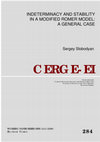
RePEc: Research Papers in Economics, 2006
This paper studies the dynamical properties of an extension of the well-known Romer model of endo... more This paper studies the dynamical properties of an extension of the well-known Romer model of endogenous growth introduced by Benhabib, Perli, and Xie (1994). This model differs from the Romer model by introducing complementarity of intermediate capital goods. It allows an indeterminate steady state for relatively mild degrees of the complementarity. We derive necessary and sufficient conditions for the steady state to be interior and strictly positive, which extend those discussed in Benhabib, Perli, and Xie (1994). We show that Hopf bifurcation to the absolutely stable steady state is impossible and that the steady state is determinate if the model parameter values belong to a certain set. For the set of parameter values that allows indeterminacy, we demonstrate the possibility of Hopf bifurcation using both analytical and numerical approaches. The indeterminate steady state can undergo Hopf bifurcation for a wide range of parameter values.
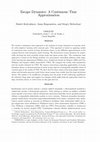
RePEc: Research Papers in Economics, Aug 11, 2004
We extend a continuous-time approach to the analysis of escape dynamics in economic models with a... more We extend a continuous-time approach to the analysis of escape dynamics in economic models with adaptive learning with constant gain. This approach is based on applying results of continuous-time version of large deviations theory to the diffusion approximation of the original discrete-time dynamics under learning. We characterize escape dynamics by analytically deriving the most probable escape point and mean escape time. The continuous-time approach is tested on the Phelps problem of a government controlling inflation while adaptively learning the approximate Phillips curve, studied previously by Sargent (1999) and Cho, Williams and Sargent (2002) (henceforth, CWS). We compare the results with simulations and the results obtained by CWS. We express reservations regarding applicability of escape dynamics theory to characterization of mean escape time for economically plausible values of constant gain in the model of CWS. We show that for these values of the gain simple considerations and formulae generate much better mean escape time results than the large deviations theory. We explain it by insufficient averaging near the point of self-confirming equilibrium for relatively large gains and suggest two changes which might help the approaches based on large deviation theory to work better in this gain interval. * {Dmitri.Kolyuzhnov, Anna.Bogomolova, Sergey.Slobodyan}@cerge-ei.cz. The second author acknowledges support provided by the World Bank through 2 nd year student fellowship. We thank Radim Bohacek, Jeong Byeongju, Michal Kejak, Andreas Ortmann, and especially Viatcheslav Vinogradov for comments and suggestions. All remaining errors are ours. † CERGE-EI is a joint workplace of the Center for Economic Research and Graduate Education, Charles University, and the Economics Institute of the Academy of Sciences of the Czech Republic. únikové dynamiky při charakterizaci průměrné doby úniku u ekonomicky přijatelných hodnot konstantního přínosu v modelu CWS. My ukazujeme,že pro tyto hodnoty přínosu poskytují jednoduché úvahy a rovnice o mnoho lepší výsledky ohledně průměrné doby úniku než teorie velkých odchylek. Vysvětlujeme to nedostatečným průměrováním v blízkosti bodu "samopotvrzujícího" bodu rovnováhy pro relativně velké přínosy a navrhujeme dvě změny, které by mohly pomoci přístupům založeným na teorii velkých odchylek fungovat lépe tomto intervalu.
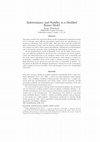
Social Science Research Network, 2002
This paper considers the well known Romer model of endogenous technological change and its extens... more This paper considers the well known Romer model of endogenous technological change and its extension where different intermediate capital goods are complementary, introduced in (Benhabib, Perli, and Xie 1994). They have shown that this modiÞcation allows indeterminate steady state for relatively mild degrees of the complementarity. The authors were able to derive analytically sufficient conditions for the indeterminacy and to Þnd speciÞc parameter values producing the indeterminate steady state. For the modiÞed Romer model of (Benhabib, Perli, and Xie 1994), I derive necessary and sufficient conditions for the steady state to be interior and strictly positive. I show that Hopf bifurcation to the absolutely stable steady state is impossible and the steady state is determinate if the model parameter values belong to a certain set. Considering a simpliÞed version of the model, I calculate necessary conditions for a Hopf bifurcation in one special case and show that it is impossible in another. Using numerical algorithm for multigoal optimization, I obtain several sets of parameter values leading to the loss of stability of the indeterminate steady state through Hopf bifurcation.
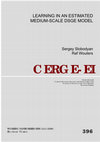
Social Science Research Network, 2009
In this paper we evaluate the empirical relevance of learning by private agents in an estimated m... more In this paper we evaluate the empirical relevance of learning by private agents in an estimated medium-scale DSGE model. We replace the standard rational expectation assumption in the Smets and Wouters (2007) model by a constant gain learning mechanism. If agents know the correct structure of the model and only learn about the parameters, both expectation mechanisms result in a similar fit, and only the transition dynamics that are generated by specific initial beliefs are responsible for the differences between the two approaches. If, in addition, agents use only a reduced information set in forming the perceived law of motion, the implied model dynamics change and for some initial beliefs the marginal likelihood of the model is further improved. The learning models with the highest posterior probabilities add some additional persistence to the DSGE model that reduce the gap between the IRFs of the DSGE model and the more data-driven DSGE-VAR model. However, the additional dynamics that are introduced by the learning process do not systematically alter the estimated structural parameters related to the nominal and real frictions in the DSGE model.
International Journal of Central Banking, Aug 24, 2018
I argue that the rather unfavorable conclusions of the three papers in the session on "Coordinati... more I argue that the rather unfavorable conclusions of the three papers in the session on "Coordination and Tradeoffs" might not be as bad as they seem. In particular, I dwell on challenges facing the central bank using an interest rate that is different from the risk-free rate in its Taylor rule, and show that proper redefinition of the intercept and the slope of the rule allows avoidance of inflationary bias and preserves the stability of equilibrium.
Macroeconomic Dynamics, Apr 3, 2013
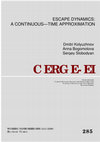
Journal of Economic Dynamics and Control, 2014
We extend a continuous-time approach to the analysis of escape dynamics in economic models with a... more We extend a continuous-time approach to the analysis of escape dynamics in economic models with adaptive learning with constant gain. This approach is based on applying results of continuous-time version of large deviations theory to the diffusion approximation of the original discrete-time dynamics under learning. We characterize escape dynamics by analytically deriving the most probable escape point and mean escape time. The continuous-time approach is tested on the Phelps problem of a government controlling inflation while adaptively learning the approximate Phillips curve, studied previously by Sargent (1999) and Cho, Williams and Sargent (2002) (henceforth, CWS). We compare the results with simulations and the results obtained by CWS. We express reservations regarding applicability of escape dynamics theory to characterization of mean escape time for economically plausible values of constant gain in the model of CWS. We show that for these values of the gain simple considerations and formulae generate much better mean escape time results than the large deviations theory. We explain it by insufficient averaging near the point of self-confirming equilibrium for relatively large gains and suggest two changes which might help the approaches based on large deviation theory to work better in this gain interval.
Computing in Economics and Finance, 2004
We thank participants of the WHEIA workshop in Trieste, Italy, and seminar participants at CERGE-... more We thank participants of the WHEIA workshop in Trieste, Italy, and seminar participants at CERGE-EI for valuable comments. Special thanks to Dmitry Kolyuzhnov. Special thanks also to Martin Dieringer who helped with early versions of the computer code. The Þrst author acknowledges Þnancial support by the Alfred P. Sloan Foundation and the Center for Adaptive Behavior and Cognition of the Max-Planck-Institut fuer Bildungsforschung in Berlin, Germany, which he was visiting while working on early versions of the computer code.
RePEc: Research Papers in Economics, 2009
This paper evaluates the empirical performance of a medium-scale DSGE model with agents forming e... more This paper evaluates the empirical performance of a medium-scale DSGE model with agents forming expectations using small forecasting models updated by the Kalman filter. The adaptive learning model fits the data better than the rational expectations (RE) model. Beliefs about the inflation persistence explain the observed decline in the mean and the volatility of inflation as well as Phillips curve flattening. Learning about inflation results in lower estimates for the persistence of the exogenous shocks that drive price and wage dynamics in the RE version of the model. Expectations based on small forecasting models are closely related to the survey evidence on inflation expectations. (JEL C53, D83, D84, E13, E17, E31)

Social Science Research Network, 2007
In their recent paper, Boldrin and Montes (2005) analyze the "return on human capital investment"... more In their recent paper, Boldrin and Montes (2005) analyze the "return on human capital investment" theory and show that if borrowing for education is not possible, then a combined public education and pension system that uses lump sum taxes and transfers can replicate the first-best decentralized allocation achieved in an economy without taxes where borrowing for human capital accumulation (education) is allowed. Taking into account that such borrowing is either absent or inefficient in many countries, a combined public education/public pensions scheme in such countries might prove to be welfare enhancing. Guided by this theoretical framework, we calibrate the parameters of an interconnected pension and education system for the Czech Republic under different demographic scenarios and fiscal rules. We also model the impact of an increase in the retirement age and of a hypothetical imbalance of pensions or educational transfers. Abstrakt V nedávném článku Boldrin a Montes (2005) analyzují teorii "výnosu z investic do lidského kapitálu" a ukazují, že když nejsou možné půjčky na vzdělání, může kombinace veřejného vzdělávání a penzijního systému, který používá daň z hlavy a transfery, replikovat nejlepší decentralizované rozdělení investic získané v ekonomice bez daní, kde je umožněno vypůjčit si za účelem akumulace lidského kapitálu (vzdělání). Když vezmeme v úvahu, že možnost takových půjček je v mnoha zemích chybějící nebo nefunkční, kombinovaný veřejný vzdělávací a penzijní systém může vest ke zvýšení blahobytu. V naší stati používáme tento teoretický rámec ke kalibraci parametrů propojeného penzijního a vzdělávacího systému pro Českou republiku v několika různých scénářích demografického vývoje a daňové politiky. Také modelujeme vliv zvýšení věku odchodu do důchodu a hypotetického znerovnovážnění důchodů nebo příspěvků na vzdělávání.
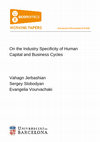
Social Science Research Network, 2016
We define specific (general) human capital as the set of occupations whose use is spread in a lim... more We define specific (general) human capital as the set of occupations whose use is spread in a limited (wide) set of industries. Using the EU Labor Force Survey database, we identify these human capital types and analyze their employment and education. This exercise yields a persistent assignment of occupations into specific and general human capital types. The share of specific human capital varies across countries and has declined over time almost everywhere. We consider a stylized two-sector model where one of the sectors uses both types of human capital and the other specializes on general human capital. We show that a mean preserving increase in the share of specific human capital reduces (increases) the contribution of shocks in non-specialized sector and increases (reduces) the contribution of shocks in specialized sector to the variance of final output, when sectoral outputs are gross complements (substitutes).
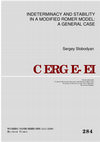
Social Science Research Network, 2006
This paper studies the dynamical properties of an extension of the well-known Romer model of endo... more This paper studies the dynamical properties of an extension of the well-known Romer model of endogenous growth introduced by Benhabib, Perli, and Xie (1994). This model differs from the Romer model by introducing complementarity of intermediate capital goods. It allows an indeterminate steady state for relatively mild degrees of the complementarity. We derive necessary and sufficient conditions for the steady state to be interior and strictly positive, which extend those discussed in Benhabib, Perli, and Xie (1994). We show that Hopf bifurcation to the absolutely stable steady state is impossible and that the steady state is determinate if the model parameter values belong to a certain set. For the set of parameter values that allows indeterminacy, we demonstrate the possibility of Hopf bifurcation using both analytical and numerical approaches. The indeterminate steady state can undergo Hopf bifurcation for a wide range of parameter values.
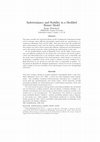
Social Science Research Network, 2003
This paper considers the well known Romer model of endogenous technological change and its extens... more This paper considers the well known Romer model of endogenous technological change and its extension where different intermediate capital goods are complementary, introduced in (Benhabib, Perli, and Xie 1994). They have shown that this modiÞcation allows indeterminate steady state for relatively mild degrees of the complementarity. The authors were able to derive analytically sufficient conditions for the indeterminacy and to Þnd speciÞc parameter values producing the indeterminate steady state. For the modiÞed Romer model of (Benhabib, Perli, and Xie 1994), I derive necessary and sufficient conditions for the steady state to be interior and strictly positive. I show that Hopf bifurcation to the absolutely stable steady state is impossible and the steady state is determinate if the model parameter values belong to a certain set. Considering a simpliÞed version of the model, I calculate necessary conditions for a Hopf bifurcation in one special case and show that it is impossible in another. Using numerical algorithm for multigoal optimization, I obtain several sets of parameter values leading to the loss of stability of the indeterminate steady state through Hopf bifurcation.
This paper evaluates the empirical performance of a medium-scale DSGE model with agents forming e... more This paper evaluates the empirical performance of a medium-scale DSGE model with agents forming expectations using small forecasting models updated by the Kalman filter. The adaptive learning model fits the data better than the rational expectations (RE) model. Beliefs about the inflation persistence explain the observed decline in the mean and the volatility of inflation as well as Phillips curve flattening. Learning about inflation results in lower estimates for the persistence of the exogenous shocks that drive price and wage dynamics in the RE version of the model. Expectations based on small forecasting models are closely related to the survey evidence on inflation expectations. (JEL C53, D83, D84, E13, E17, E31)
Journal of Economic Dynamics and Control
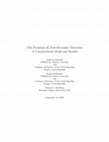
We propose a computational model to study (the evolution of) post-secondary education.“Consumers ... more We propose a computational model to study (the evolution of) post-secondary education.“Consumers ” that differ in quality shop around for desirable colleges or universities. “Firms ” that differ in quality signal the availability of their services to desirable students. Colleges and universities, as long as they have capacity, make offers to students that apply and qualify. We study the dynamics and asymptotics for three nested variants of this matching model: the first variant replicates the Vriend (1995) model, the second stratifies both firms and consumers by quality, while the third variant of our model equips some firms additionally with economies of scale. The last variant of our model is motivated by the entry of for-profit providers into some segements of post-secondary education in the USA and empirical evidence that, while traditional nonprofit or state-supported providers of higher education do not have significant economies of scale, the new breed of for-profit providers...
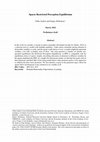
Research Papers in Economics, 2018
In this paper we study model selection under bounded rationality and the impact of monetary polic... more In this paper we study model selection under bounded rationality and the impact of monetary policy on the equilibrium choice of forecasting models. We use the concept of sparse rationality (developed recently by Gabaix, 2014), where paying attention to all possible variables is costly and agents can choose to over- or under-emphasize particular variables, even fully excluding some of them. Our main question is whether an initially mis-specified equilibrium (the restricted perceptions equilibrium, or RPE) is compatible with the equilibrium choice of sparse weights describing the allocation of attention to different variables by the agents inhabiting this RPE. In a simple New Keynesian model, we find that the agents stick to their initial mis-specified AR(1) forecasting model choice when monetary policy is less aggressive or inflation is more persistent. We also identify a region in the parameter space where the agents find it advantageous to pay attention to no variable at all.
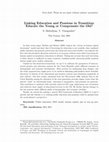
In their recent paper, Boldrin and Montes (2005) analyze the “return on human capital investment”... more In their recent paper, Boldrin and Montes (2005) analyze the “return on human capital investment” model and show that if borrowing for education is not possible, then combined public education and pension system that uses lump sum taxes and transfers, can replicate the first—best decentralized allocation achieved in an economy without taxes where borrowing for human capital accumulation (education) is allowed. Taking into account that such borrowing is either absent or inefficient in many countries, combined public education/public pensions scheme might prove welfare enhancing. Guided by this theoretical framework, we use it to calibrate the parameters of interconnected pension and education systems for the Czech Republic under different scenarios of demographic and economic development. Both systems are undergoing deep changes, and the study proposed here might prove to be useful in informing policymakers about desirable directions of reforms of the educational and pension systems ...









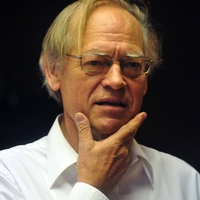

Uploads
Papers by Sergey Slobodyan